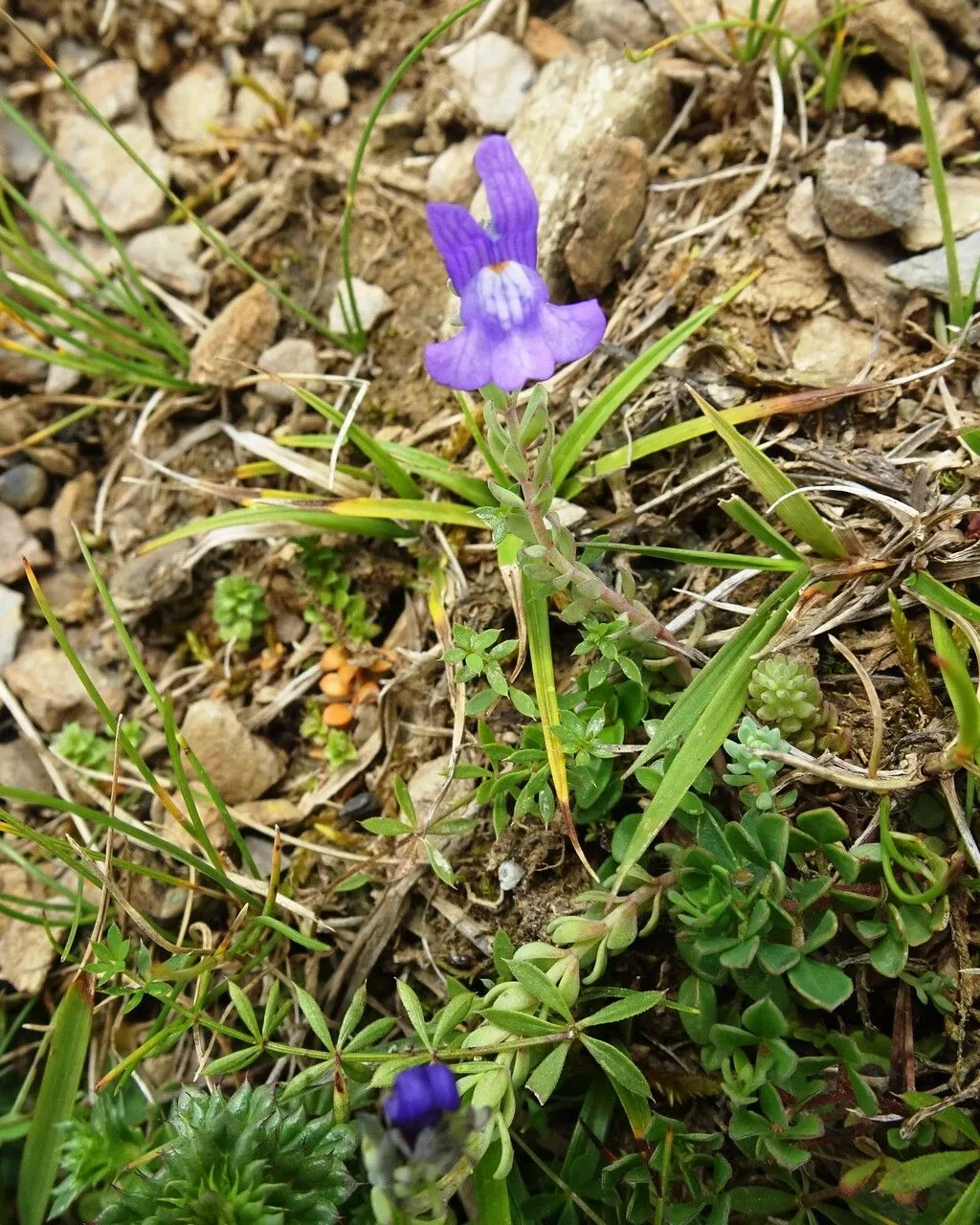
Author: Mill.
Bibliography: Gard. Dict. ed. 8: n.º 4 (1768)
Year: 1768
Status: accepted
Rank: species
Genus: Linaria
Vegetable: False
Observations: Mts. of C. & S. Europe
Alpine toadflax is a vibrant and resilient flowering plant, known scientifically as Linaria alpina. This striking species is a member of the Plantaginaceae family and is noted for its adaptability to mountainous environments, particularly across Central and Southern Europe.
The plant’s robust nature allows it to thrive in rocky, alpine terrains where other vegetation may struggle to survive. Its slender, erect stems are often adorned with clusters of small, yet vivid, purple-blue flowers, typically displaying an enchanting splash of orange at the centers. This color combination not only makes Linaria alpina a visually appealing species but also contributes to its popularity among botanists and horticulturists.
First detailed in the 8th edition of the “Gardener’s Dictionary” in 1768 by the author Mill., Alpine toadflax has since been a subject of interest due to its unique habitat preferences and striking floral characteristics. Despite the harsh conditions of its native mountainous regions, where it endures cold temperatures and high altitudes, this resilient plant manages to flourish, showcasing nature’s incredible adaptability.
Alpine toadflax is often used in rock gardens and alpine plant collections, where its beauty and hardiness can be appreciated up close. When cultivating Linaria alpina, gardeners benefit from its low maintenance requirements and its natural resistance to many common pests and diseases. This makes it an excellent choice for those seeking an aesthetic yet durable addition to their plant repertoire.
Moreover, its ecological role in its native habitats should not be underestimated. It provides necessary food for pollinators, including bees and butterflies, which rely on its nectar. Its presence in mountainous ecosystems also helps in stabilizing soil and preventing erosion, thus contributing to the overall health of its environment.
In summary, Alpine toadflax (Linaria alpina) is a visually stunning and ecologically vital plant that prospers in the harsh conditions of European mountain ranges. Its ease of cultivation and natural beauty make it a cherished addition to gardens and a subject of continued botanical study.
Dan: alpe-torskemund
Deu: alpen-leinkraut
Swe: alpsporre
En: Alpine toadflax
Ca: Linària alpina
Cs: Lnice alpská, Lnice alpínská
Da: Alpe-torskemund
Nl: Alpenleeuwenbek, Alpenleeuwebek
Et: Alpi käokannus
Fi: Alppikannusruoho
Fr: Linaire des Alpes
De: Alpen-Leinkraut
It: Linajola alpina
Ro: Linariță de munte
Sk: Pyštek alpínsky
Es: Palomilla alpina
Sv: Alpsporre
: Alpen-leinkraut
© copyright of the Board of Trustees of the Royal Botanic Gardens, Kew.
© copyright of the Board of Trustees of the Royal Botanic Gardens, Kew.
Taken Jul 5, 2019 by Carry Rambausek (cc-by-sa)
Taken Mar 26, 2020 by Guillaume Labeyrie (cc-by-sa)
Taken Jul 30, 2018 by Sophie Dashwood (cc-by-sa)
Taken Jul 13, 2019 by Hugo Padilla (cc-by-sa)
Taken Sep 11, 2021 by Vincenc J (cc-by-sa)
Taken Sep 10, 2020 by Figl Toni (cc-by-sa)
Taken Jul 31, 2022 by huy HO (cc-by-sa)
Taken Jul 16, 2021 by Daniel Barthelemy (cc-by-sa)
Taken Jun 16, 2022 by manuseitz (cc-by-sa)
Taken Jul 29, 2021 by Alain Bigou (cc-by-sa)
Taken Sep 5, 2022 by Didier (cc-by-sa)
Taken Sep 5, 2022 by Didier (cc-by-sa)
Taken Sep 5, 2022 by Didier (cc-by-sa)
Taken Jun 16, 2022 by manuseitz (cc-by-sa)
Taken Jul 31, 2022 by huy HO (cc-by-sa)
Taken Jul 10, 2021 by Jani Zadrgal (cc-by-sa)
Taken Jun 16, 2022 by manuseitz (cc-by-sa)
Taken Aug 19, 2018 by Varrey Daniel (cc-by-sa)
Taken Oct 30, 2020 by euphrosiine M (cc-by-sa)
Taken Jul 29, 2021 by Alain Bigou (cc-by-sa)
Taken Jul 28, 2021 by Renaud Brochiero (cc-by-sa)
Taken Jun 24, 2017 by Yoan MARTIN (cc-by-sa)
Taken Aug 7, 2022 by Tristan Jaton-Maria (cc-by-sa)
Taken May 19, 2022 by Jacques Zuber (cc-by-sa)
Taken May 19, 2012 by Tela Botanica − Yoan MARTIN (cc-by-sa)
Taken Sep 21, 2019 by Jäger Latein (cc-by-sa)
Taken Jun 16, 2022 by manuseitz (cc-by-sa)
Taken Jul 29, 2021 by Alain Bigou (cc-by-sa)
Taken Aug 25, 2019 by Anna G (cc-by-sa)
Taken Jul 12, 2013 by Tela Botanica − Françoise CARLE (cc-by-sa)
Ph maximum: 8.0
Ph minimum: 7.5
Light: 9
Atmospheric humidity: 5
Bloom months: [‘jun’, ‘jul’, ‘aug’, ‘sep’]
Soil nutriments: 2
Family: Myrtaceae Author: (F.Muell.) K.D.Hill & L.A.S.Johnson Bibliography: Telopea 6: 402 (1995) Year: 1995 Status:…
Family: Rubiaceae Author: Pierre ex A.Froehner Bibliography: Notizbl. Bot. Gart. Berlin-Dahlem 1: 237 (1897) Year:…
Family: Sapindaceae Author: Koidz. Bibliography: J. Coll. Sci. Imp. Univ. Tokyo 32(1): 38 (1911) Year:…
Family: Asteraceae Author: A.Gray Bibliography: Pacif. Railr. Rep.: 107 (1857) Year: 1857 Status: accepted Rank:…
Family: Fabaceae Author: Medik. Bibliography: Vorles. Churpfälz. Phys.-Ökon. Ges. 2: 398 (1787) Year: 1787 Status:…
Family: Aspleniaceae Author: (Cav.) Alston Bibliography: Bull. Misc. Inform. Kew 1932: 309 (1932) Year: 1932…